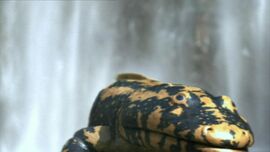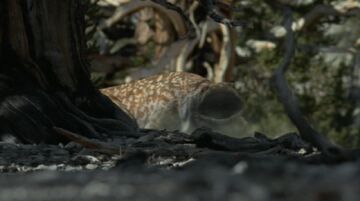No edit summary |
(Changed that Amphibians are actually a monophyletic group and removed the qutation- marks around the word amphibian(s)) Tag: Visual edit |
||
| Line 2: | Line 2: | ||
| − | [[File:Hynerpeton.jpg|thumb|270px|''Hynerpeton'', a type of amphibian.]]'''Amphibians''' are a |
+ | [[File:Hynerpeton.jpg|thumb|270px|''Hynerpeton'', a type of amphibian.]]'''Amphibians''' are a monophyletic grouping of basal tetrapods - [[File:Amphibian_mouth_open.jpg|thumb|360px|A ''[[Seymouria]]'', lurking in the shadows of the early [[Permian]].]]four-legged vertebrate animals that have to exist in both aquatic and terrestrial environments. Existing since the [[Devonian]] time period (when the amphibians began to emerge onto land and even dig crude burrows to escape the heat of the sun), their closest relatives potentially are [[Hyneria|lungfish]] of [[Africa]], Australia and [[South America]], whose fry closely resemble the larvae of some amphibians (and vice versa). Most amphibians have four legs, but some have only two, while the caecilians got rid of legs altogether. Many amphibians (especially those living in the tropics) are endangered. |
| Line 10: | Line 10: | ||
==Known Species== |
==Known Species== |
||
| − | '''Impossible Pictures''' has shown the following |
+ | '''Impossible Pictures''' has shown the following amphibian species: |
'''- ''[[Hynerpeton]]'':''' An early tetrapod of the [[Devonian]] (Walking with monsters, ep 1), it was shown hunting small invertebrates like [[scorpion]]s, and being food for large creatures, such as the huge lobe-finned fish ''[[Hyneria]]'' and fresh-water sharks. |
'''- ''[[Hynerpeton]]'':''' An early tetrapod of the [[Devonian]] (Walking with monsters, ep 1), it was shown hunting small invertebrates like [[scorpion]]s, and being food for large creatures, such as the huge lobe-finned fish ''[[Hyneria]]'' and fresh-water sharks. |
||
| − | '''- ''[[Proterogyrinus]]'': '''A later |
+ | '''- ''[[Proterogyrinus]]'': '''A later amphibian that lived during the [[Carboniferous]] (Walking with monsters, ep 2). It was actually an anthracosaur, a relative of amniotes. It was shown hunting such creatures as ''[[Arthropleura]]'' and ''[[Meganeura]]'', but it was mainly used by the show as a general stand-in for all of the Carboniferous amphibians. It played a secondary, or even a tertiary role in the episode's narration, and it died out when the reptiles evolved by the early Permian time period. |
| − | '''- ''[[Seymouria]]:''''' Another Anthracosaur from the early [[Permian]] (Walking with monsters, ep 2). It was a secondary character of that episode, harassing a ''[[Dimetrodon]]'s'' nest, but eventually killed by another ''Dimetrodon''. ''Seymouria'' served as an example as to how |
+ | '''- ''[[Seymouria]]:''''' Another Anthracosaur from the early [[Permian]] (Walking with monsters, ep 2). It was a secondary character of that episode, harassing a ''[[Dimetrodon]]'s'' nest, but eventually killed by another ''Dimetrodon''. ''Seymouria'' served as an example as to how amphibians got overshadowed by the amniotes ("Reptiles") on land quite quickly: crocodile-like ''Proterogyrinus'' and much-smaller ''Seymoria'' are shown almost side-by-side with their [[File:Kool.png|thumb|link=Special:FilePath/Kool.png]]reptilian neighbors, ''[[Petrolacosaurus]]'' and the [[pelycosaur]]s of early Permian, and clearly illustrate the descent of amphibians from the dominant evolutionary roles. |
| − | '''- [[Labyrinthodont]] (''Rhinesuchus''): '''An |
+ | '''- [[Labyrinthodont]] (''Rhinesuchus''): '''An amphibian from the late Permian (Walking with monsters, ep 3). It was a 'living fossil' of sorts, a remnant of the earlier, Carboniferous time that was stalked and eventually killed and eaten by a [[gorgonopsid]] - a protomammal ("Mammal-like reptile") (Non-mammalian synapsid). Unlike earlier amphibians, ''Rhinesuchus'' could hibernate in a torpid state by cocooning deep under a layer of mud, but it died out during the Permian-Triassic mass extinction all the same. |
'''- ''[[Metoposaur]]s'':''' Were a group of primitive amphibians from the early Triassic time period (Walking with dinosaurs, ep 1 - book only). They were similar to the bigger ''Mastodontosaurus'', which lived at the same time, but in Europe, and to the earlier ''Rhinesuchus''. They were fully aquatic, and this is why they were able to survive until the middle-Triassic, when first true aquatic reptiles, like ''[[Proterosuchus]]'' appeared and drove them into extinction. |
'''- ''[[Metoposaur]]s'':''' Were a group of primitive amphibians from the early Triassic time period (Walking with dinosaurs, ep 1 - book only). They were similar to the bigger ''Mastodontosaurus'', which lived at the same time, but in Europe, and to the earlier ''Rhinesuchus''. They were fully aquatic, and this is why they were able to survive until the middle-Triassic, when first true aquatic reptiles, like ''[[Proterosuchus]]'' appeared and drove them into extinction. |
||
| − | '''- ''[[Mastodonsaurus]]'': '''An |
+ | '''- ''[[Mastodonsaurus]]'': '''An amphibian from the early [[Triassic]] (Walking with dinosaurs, ep 1; Sea monsters, ep 1 - books only). This was an amphibian similar to ''Rhinesuchus'' in terms of ecology, but larger and more squat in shape. It is a background character in the books and by the middle Triassic it died out completely. |
'''- ''' |
'''- ''' |
||
'''-''[[Koolasuchus]]'':''' A temnospondyl from the middle to late [[Cretaceous ]](Walking with dinosaurs, ep 5). It was another 'living fossil', a remnant of the past that lived in Cretaceous Australia/New Zealand in an ecological niche similar to crocodilians - reptiles that had evolved by that time. It resembled a giant salamander in size and was an aquatic predator behavior-wise: it harassed dinosaur young, but was more successful as a scavenger instead. Like ''Rhinesuchus'' before it, it too could hibernate, by burying itself under mud, and like ''Rhinesuchus'', it died out before its' dinosaur neighbors and contemporaries did. |
'''-''[[Koolasuchus]]'':''' A temnospondyl from the middle to late [[Cretaceous ]](Walking with dinosaurs, ep 5). It was another 'living fossil', a remnant of the past that lived in Cretaceous Australia/New Zealand in an ecological niche similar to crocodilians - reptiles that had evolved by that time. It resembled a giant salamander in size and was an aquatic predator behavior-wise: it harassed dinosaur young, but was more successful as a scavenger instead. Like ''Rhinesuchus'' before it, it too could hibernate, by burying itself under mud, and like ''Rhinesuchus'', it died out before its' dinosaur neighbors and contemporaries did. |
||
| − | '''- ''[[Tree frog]]'':''' Is an anatomically modern frog that was sunning itself on a branch when a ''[[Leptictidium]]'' caught and ate it, using its' warm-blooded metabolism to gain advantage on the slower, cold-blooded amphibian.[[File:449px-Laubfrosch cropped.jpg|thumb|Tree frog.]] |
+ | '''- ''[[Tree frog]]'':''' Is an anatomically modern frog that was sunning itself on a branch when a ''[[Leptictidium]]'' caught and ate it, using its' warm-blooded metabolism to gain advantage on the slower, cold-blooded amphibian.[[File:449px-Laubfrosch cropped.jpg|thumb|Tree frog.|link=Special:FilePath/449px-Laubfrosch_cropped.jpg]] |
[[Category:Walking with Dinosaurs Animals]] |
[[Category:Walking with Dinosaurs Animals]] |
||
[[Category:Walking with Monsters Animals]] |
[[Category:Walking with Monsters Animals]] |
||
Revision as of 10:51, 13 January 2021

Hynerpeton, a type of amphibian.
Amphibians are a monophyletic grouping of basal tetrapods -

four-legged vertebrate animals that have to exist in both aquatic and terrestrial environments. Existing since the Devonian time period (when the amphibians began to emerge onto land and even dig crude burrows to escape the heat of the sun), their closest relatives potentially are lungfish of Africa, Australia and South America, whose fry closely resemble the larvae of some amphibians (and vice versa). Most amphibians have four legs, but some have only two, while the caecilians got rid of legs altogether. Many amphibians (especially those living in the tropics) are endangered.
Known Species
Impossible Pictures has shown the following amphibian species:
- Hynerpeton: An early tetrapod of the Devonian (Walking with monsters, ep 1), it was shown hunting small invertebrates like scorpions, and being food for large creatures, such as the huge lobe-finned fish Hyneria and fresh-water sharks.
- Proterogyrinus: A later amphibian that lived during the Carboniferous (Walking with monsters, ep 2). It was actually an anthracosaur, a relative of amniotes. It was shown hunting such creatures as Arthropleura and Meganeura, but it was mainly used by the show as a general stand-in for all of the Carboniferous amphibians. It played a secondary, or even a tertiary role in the episode's narration, and it died out when the reptiles evolved by the early Permian time period.
- Seymouria: Another Anthracosaur from the early Permian (Walking with monsters, ep 2). It was a secondary character of that episode, harassing a Dimetrodon's nest, but eventually killed by another Dimetrodon. Seymouria served as an example as to how amphibians got overshadowed by the amniotes ("Reptiles") on land quite quickly: crocodile-like Proterogyrinus and much-smaller Seymoria are shown almost side-by-side with their
reptilian neighbors, Petrolacosaurus and the pelycosaurs of early Permian, and clearly illustrate the descent of amphibians from the dominant evolutionary roles.
- Labyrinthodont (Rhinesuchus): An amphibian from the late Permian (Walking with monsters, ep 3). It was a 'living fossil' of sorts, a remnant of the earlier, Carboniferous time that was stalked and eventually killed and eaten by a gorgonopsid - a protomammal ("Mammal-like reptile") (Non-mammalian synapsid). Unlike earlier amphibians, Rhinesuchus could hibernate in a torpid state by cocooning deep under a layer of mud, but it died out during the Permian-Triassic mass extinction all the same.
- Metoposaurs: Were a group of primitive amphibians from the early Triassic time period (Walking with dinosaurs, ep 1 - book only). They were similar to the bigger Mastodontosaurus, which lived at the same time, but in Europe, and to the earlier Rhinesuchus. They were fully aquatic, and this is why they were able to survive until the middle-Triassic, when first true aquatic reptiles, like Proterosuchus appeared and drove them into extinction.
- Mastodonsaurus: An amphibian from the early Triassic (Walking with dinosaurs, ep 1; Sea monsters, ep 1 - books only). This was an amphibian similar to Rhinesuchus in terms of ecology, but larger and more squat in shape. It is a background character in the books and by the middle Triassic it died out completely. -
-Koolasuchus: A temnospondyl from the middle to late Cretaceous (Walking with dinosaurs, ep 5). It was another 'living fossil', a remnant of the past that lived in Cretaceous Australia/New Zealand in an ecological niche similar to crocodilians - reptiles that had evolved by that time. It resembled a giant salamander in size and was an aquatic predator behavior-wise: it harassed dinosaur young, but was more successful as a scavenger instead. Like Rhinesuchus before it, it too could hibernate, by burying itself under mud, and like Rhinesuchus, it died out before its' dinosaur neighbors and contemporaries did.
- Tree frog: Is an anatomically modern frog that was sunning itself on a branch when a Leptictidium caught and ate it, using its' warm-blooded metabolism to gain advantage on the slower, cold-blooded amphibian.
Tree frog.
